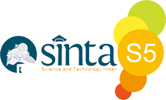KARAKTERISASI MORFOLOGI TANAMAN PEKAWAI (Durio kutejensis) Hassk. Becc KOLEKSI KEBUN PERCOBAAN UNIVERISTAS KAPUAS SINTANG KALIMANTAN BARAT
Abstract
The diversity of the Durio genus in West Kalimantan is the highest in Indonesia, one of which is Pekawai (Durio kutejensis). The loss of pekawai genetic resources is a threat due to deforestation. So that real efforts are needed through intensive development through ex-situ and in-situ conservation. The purpose of the study was to obtain information on the morphological diversity of the Pekawai in the Experimental Garden of the Kapuas Sintang University. The research method used purposive sampling, the observed morphological characters were 24 characters consisting of 7 stem characters, 11 leaf characters and 6 fruit characters. Morphological descriptions were analyzed by scoring cluster analysis and dendrogram using the Unweighed Pair-Group Method Arithmetic Average (UPGMA) using the Numerical Taxonomic and Multivariate System (NTSYS) version 2.10 program. The results of the study were 24 morphological characters of leaf stems and fruit against 7 accessions of Pekawai which had a similarity coefficient of 0.78-0.96 or a diversity of 4%-22%. At the coefficient of 0.83 formed 3 main groups. Group I there are 4 accessions with a similarity of 11 characters. At a coefficient of 0.87, they formed 2 groups, 1. UNKA1 and UNKA2 with 21 morphological similarities. 2. GM2 and GM 3 with 20 similarities. Group II. Grouped based on 19 morphological characters, namely GM2 and GM3. Group III. GM5 Morphological similarity 11 characters. The conclusion is that the morphological characterization of 7 Pekawai accessions is known to have a similarity at a coefficient of 0.78 or a diversity of 22%
Keywords
Pekawai; Durio kutejensis; Characterization; Analysis UPGMA; NTSYS
Full Text:
PDFDOI: http://dx.doi.org/10.36764/ja.v6i2.877
Refbacks
- There are currently no refbacks.

Ciptaan disebarluaskan di bawah Lisensi Creative Commons Atribusi 4.0 Internasional













